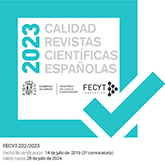Noé en Mérida (Augusta Emérita)
DOI:
https://doi.org/10.3989/aespa.2000.v73.331Keywords:
Roman sarcophagus, Roman relief, Early Christian iconography, Noah, Augusta Emerita, 3rd century AD.Abstract
For a long time, a relief, preserved in the Museo Nacional de Arte Romano in Mérida (Badajoz, Spain) has been considered to be a representation of the oriental god Mithras Saxigenus and, therefore, as another witness of the oriental cults in the ancient capital of Lusitânia. Although some authors interpreted it differently, as a funeral banquet with a portrait of the dead person, nobody has yet proposed the Christian interpretation presented here: the image of Noah emerging from the Ark, shown on the front of a sarcophagus lid, and the representation of a celestial banquet celebrating the salvation of the dead. The piece is dated to the last quarter of the 3rd century AD and thus is the first archaeological evidence of Christianity in the colonia Augusta Emerita
Downloads
Download data is not yet available.
Downloads
Published
2000-12-30
How to Cite
Arce, J. (2000). Noé en Mérida (Augusta Emérita). Archivo Español De Arqueología, 73(181-182), 285–293. https://doi.org/10.3989/aespa.2000.v73.331
Issue
Section
News
License
Copyright (c) 2000 Consejo Superior de Investigaciones Científicas (CSIC)

This work is licensed under a Creative Commons Attribution 4.0 International License.
© CSIC. Manuscripts published in both the printed and online versions of this Journal are the property of Consejo Superior de Investigaciones Científicas, and quoting this source is a requirement for any partial or full reproduction.All contents of this electronic edition, except where otherwise noted, are distributed under a “Creative Commons Attribution 4.0 International” (CC BY 4.0) License. You may read here the basic information and the legal text of the license. The indication of the CC BY 4.0 License must be expressly stated in this way when necessary.
Self-archiving in repositories, personal webpages or similar, of any version other than the published by the Editor, is not allowed.














